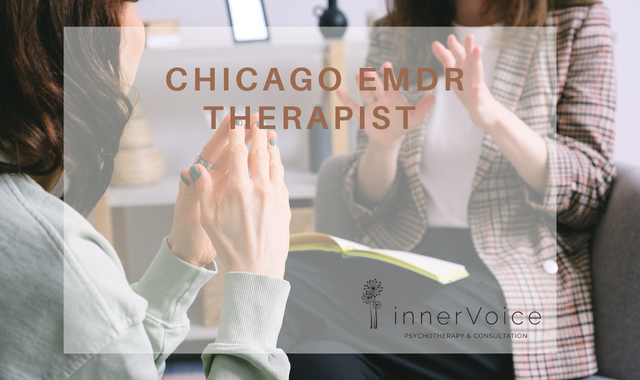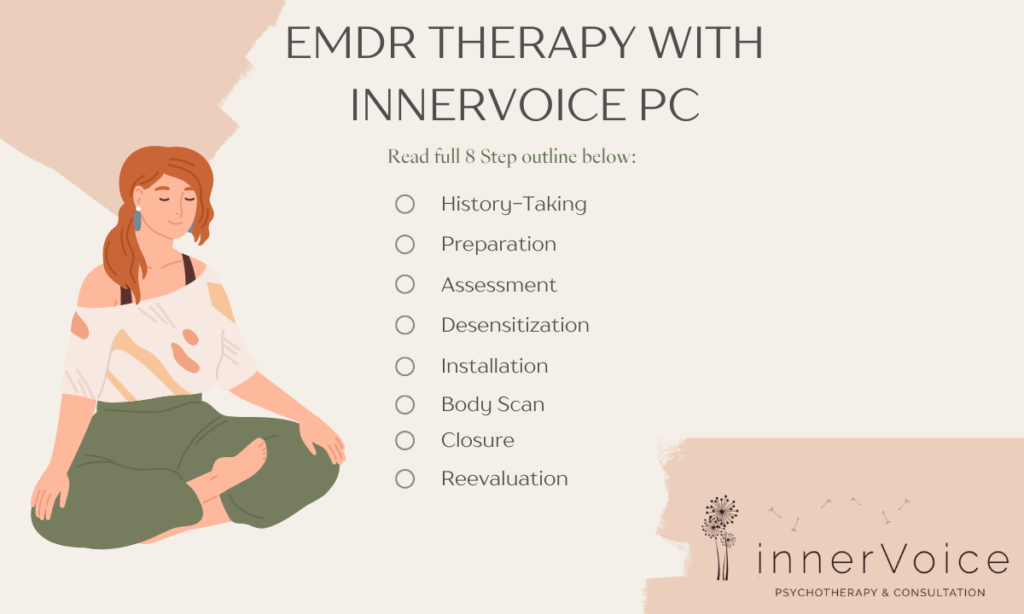
How to Find an Effective Chicago EMDR Therapist?
What is EMDR therapy? Eye Movement Desensitization & Bilateral Stimulation explained.
EMDR stands for eye movement desensitization and reprocessing. EMDR therapy approaches mental health – particularly painful events and negative beliefs, using eye movement desensitization. Bilateral stimulation is used to induce eye movement, which, through multiple sessions, can often calm emotional distress. Why, though? Bilateral stimulation occurs when the human eye tracks an object moving from left to right. This is the same rapid eye movement that occurs during sleep, which is often one way people manage mental health in daily life. Another method uses audio stimulation in the left and right ears as well. Thus, EMDR therapists utilize this method of manipulating eye movements to treat the patient’s presenting concerns. EMDR sessions are typically a form of brief treatment, often lasting 60-90 minutes. EMDR is often used alongside other forms of treatment.
What disorders can EMDR therapy approaches treat?
EMDR processing, along with you and your therapist’s treatment plan, can help with processing disturbing memories, substance abuse, trauma, anxiety, eating disorders, PTSD, panic attacks, and negative past experiences. EMDR therapists can combine EMDR with several treatment approaches to address the individual’s present concerns. Depending on the individual’s treatment goals, EMDR treatment can adaptively manage distressing life experiences and aid with the reprocessing of several cognitive stressors. People seeking treatment expressing concerns about issues such as post-traumatic stress disorder and memories of a disturbing event often find eye movement desensitization and reprocessing to provide a safe space to manage these alarming experiences.
What are the advantages of EMDR therapy?
If you are curious about integrating EMDR treatment planning into your next session, it is essential to understand all the details of what makes EMDR different from most therapy approaches. This will help you understand if it is right for you and your symptoms. Other therapy approaches typically focus on establishing a treatment revolving around talk therapy. This helps the patient reach their treatment goals by socially working through their cognitive distress. EMDR focuses in a more bodily way- focusing on body sensations and working directly with the science of the brain to bolster emotional health. If you are uncomfortable with doing a great deal of talking about a negative experience or traumatic memories, EMDR can help you safely manage and process your negative emotions. One of the reasons people may typically avoid psychotherapy, even though they may actually desire to go, is that talk therapy typically involves a great deal of shuffling through negative memories. Particularly for people with trauma disorders, this can cause great distress. This can, unfortunately, be a deterrent to the person reaching their mental health goals. EMDR allows the patient to process their trauma and other emotional distress.
Does EMDR work?
EMDR works around the fundamental theory that when a patient has had a negative experience, the left and right sides of the brain may cease communicating about the event. This treatment can allow the patient to restore that communication and re-frame their issue around new insights they discover- on their own, with the aid of the therapist- and form a new, positive belief around their cognitive distress as they free associate. Clinical psychologist Francine Shapiro developed EMDR.
The American Psychiatric Association describes how Dr. Shapiro developed the method by understanding that trauma and other distressing life experiences are often not processed in our memory. The clinician practicing the technique must establish a positive therapeutic relationship with the patient. As with all forms of therapy, there is the risk of psychological distress. But it is important to understand that, when practiced with licensed and trained mental health professionals, EMDR has been proven to be highly effective. The patient must feel comfortable and open with their therapist to ensure its efficacy. EMDR is considered to be safe when done properly. Still, it is essential to establish the aforementioned relationship and ensure that your therapist is knowledgeable about this kind of treatment and well-trained in its application. The most commonly reported side effects include fatigue or relatively mild physical discomfort.
EMDR for post-traumatic stress disorder
In 2013, the World Health Organization released recommendations and guidelines regarding treatment for people reprocessing trauma. They recommend multiple forms of psychotherapy, including cognitive behavioral therapy (CBT) and EMDR. EMDR therapists find particular success with those suffering from trauma because of the aforementioned reasons- allowing cognitive reprocessing through the bilateral stimulation treatment processes. People are seeking treatment expressing concerns about issues such as PTSD and specific memories of a disturbing event often find eye movement desensitization and reprocessing to provide a safe space to manage these disturbing experiences.
Potential drawbacks to EMDR therapy
As with any therapeutic practice, there can be drawbacks. As stated previously, you will be trudging through your dark thoughts. These thoughts can be difficult to reflect on and work with, which can be a potential obstacle for some patients. In addition, some patients may find it hard to translate what was learned about their thoughts and emotions in the session into their daily life. Lastly, the process by which the eye movements are induced may be distracting or uncomfortable for some.
Finding EMDR therapists in Chicago
When seeking EMDR therapy, finding the right therapist for your particular issues is essential. Getting through the trauma is often present for those seeking these treatment approaches is complex and requires the correct EMDR therapist. Searching the internet for the right fit is often tedious, and you may need to look into many unfamiliar terms. In addition, your therapists must be trained in EMDR therapy to get the most out of you. Additionally, it is essential to be in an environment that is comfortable, convenient, and conducive to your treatment. It can be beneficial, then, to find a therapist who offers in-person as well as online treatment options for EMDR.
Inner Voice PC
The therapists at Inner Voice Psychotherapy and Consultation (IVPC) in Chicago may be right for you. For starters, the entire IVPC staff has been trained to perform EMDR therapy and can quickly provide EMDR therapy as part of your treatment plan. Whether your overall treatment plan requires you to address anxiety, disturbing memories, or other forms of trauma, or if you possess other treatment goals, your therapist can go through all the necessary details to achieve your desired adaptive resolution.
Online EMDR therapy options with Inner Voice PC
Post-COVID-19, many therapists have decided to continue offering therapy online. Online therapy extends beyond CBT or other forms of therapy. Online EMDR allows you to participate in the treatment without being physically present with the therapist. While it is true that there is relatively little information on how effective teletherapy EMDR is in comparison to in-person EMDR therapy, therapists with IVPC have seen many successes with online EMDR therapy.
Their online therapy platform operates on HIPAA-compliant technology, ensuring the safety of your private data. Conversations are not recorded; as with any healthcare treatment, whatever you say during the EMDR treatment is entirely confidential. If you do choose to receive EMDR therapy over an online platform, it is essential that you feel you are in a safe and comfortable environment to increase the efficacy of the treatment. You should perform EMDR therapy in a space such as your home instead of in a less comfortable or more public space. This is far more conducive to allowing you to manage those feelings safely.
What to expect when getting EMDR therapy with InnerVoice PC!

Your EMDR therapist can, of course, guide you on the specifics. But it can be helpful to have an idea of what it might be like to get it done and the things that your therapist will do and have you do during the process. EMDR proceeds via an eight-step process that typically takes multiple sessions of work. These steps will be outlined here and can also be found on IVPC’s website:
Step One: History-Taking
The therapist will discuss with you your past experiences and specific memories. They will discuss how this trauma affected you in terms of the impact on your life and the emotional distress caused by these memories. This will allow the therapist to understand painful events and how to proceed with the treatment plan.
Step Two: Preparation
The therapist will brief you on the treatment and assess whether it is safe for you.
Step Three: Assessment
This is where awareness of your thoughts and feelings around your memories and/or traumatic experiences will be fostered.
Step Four: Desensitization
This is where the bilateral stimulation begins. The therapist will use these methods to allow you to process the events we have just assessed.
Step Five: Installation
This is where you will begin to insert positive beliefs in place of negative thoughts regarding your life experiences.
Step Six: Body Scan
This is where the therapist will ask you to check in with your body and be mindful of your body sensations.
Step Seven: Closure
In this step, you and the clinician discuss what you’ve learned and felt throughout your session.
Step Eight: Reevaluation
This step is focused on utilizing what you learned in this treatment in your daily life.
As you continue your journey with EMDR, you will typically do this for multiple sessions. As your memories and their emotional/psychological context become clearer for you, the goal is to move your traumatic memories from an unresolved and confusing state and change the perspective with which you think of them to a present adaptive perspective.
Booking EMDR therapy with Chicago-based InnerVoice PC
Booking any therapy session can be challenging to navigate. It can be tough to push yourself to get the treatment you need, and with something like EMDR, it can be difficult to know if it is right for you.
Through this post, however, you’ve been guided into a further understanding of what EMDR is, how it works, whether it is effective, and- perhaps most importantly – the best place in Chicago to find this treatment approach. Because of IVPC’s repeated success with patients participating in EMDR, our therapists receive extensive EMDR training in addition to our already existing therapeutic training and their high-quality online option, so it may be time to reach out to them. You can find a link to the explanation of how we operate with EMDR and why we are such firm believers in it here.
To book an appointment, you can visit EMDR Therapy Chicago or call us at 312.620.1420 .
You do not have to live with unresolved traumatic memories. Many options are available to help you take the active steps to resolve those memories. EMDR is an excellent option for undergoing that process, and getting in touch with the professionals at IVPC can get you more information on whether it is right for you.